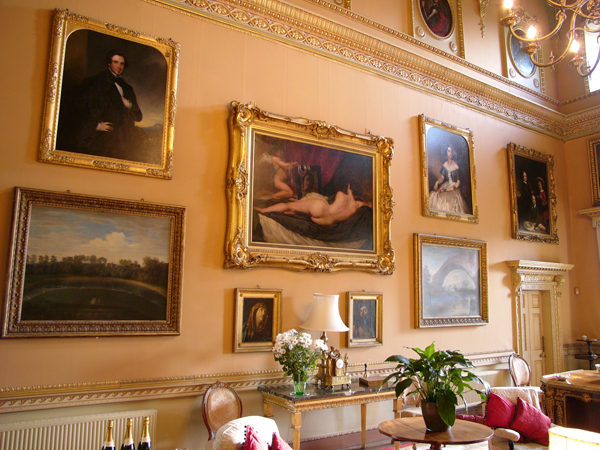In the afternoon we proceeded to Rokeby, a quintessential neo-Palladian house built by an amateur architect for himself. In order to understand the arrangement of the house we gathered in front of the south façade where Sally Davies, the current administrator of the house, introduced the physical architecture and the personalities, Sir Thomas Robinson, J. S Morritt and his son J.B.S. Morritt, who created and developed the house throughout the 18th century.
Sir Thomas Robinson inherited the Rokeby estate in 1720 and when he came of age a few years later (probably in 1723) he set about replacing the old house with a completely up-to-date and fashionable variant of the Palladian villa form. Robinson was clearly a skilled, enthusiastic and well-educated amateur architect and his friendship with Lord Burlington, Palladianism’s chief patron and exponent in England, meant he was well placed to produce an interesting exemplar of this new style. Although the house was ‘entirely fitted up to be warm and convenient’ by 1731, Robinson continued to remodel the house to keep up with the latest fashions over the next twenty years. Robinson sold the estate in 1769 to J. S. Morritt . The house was advertised with its contents and Morritt certainly acquired many of the fixtures, furnishings and paintings. The house is still owned by the Morritt family today and over the years they have added many of their own treasurers so sometimes identifying how and when objects came into the house can be difficult.
The Morritts also made changes to the house including the creation of a dining room. The overall design is attributed to John Carr of York and stylistically dates to the 1770s. There was an interesting discussion as to whether some of the white painted furniture for room, a sideboard, pier tables and pedestals, could also have been designed by Carr.
The house contains many fascinating objects. Some of the most remarkable are a large series of textured needlework pictures based on oil paintings or prints by J. S. Morritt’s eldest sister Anne. As regards furniture we were intrigued by several quirky designs such as the Chinese-inspired dining chairs in the breakfast room and the wine coolers in the dining room (Colonial?). We admired the workmanship of the 1930s reproductions by Malletts of the three exceptional pieces by William Vile that were sold to Queen Mary and are now in the Royal Collections. But perhaps the object that created the most interest was the font from the parish church which is now in the Saloon. Robinson designed the church but it was not completed when he sold the estate. However, the advertisement for the sale noted that it would be finished at Robinson’s expenses and so presumably to his design. The font is in the form of a Graeco-Roman tripod known as an athenienne and the form and name seem to derive from a 1762 painting by Joseph-Marie Vien. It is not know whether Robinson designed the font or not but he would have certainly approved of its classical origins.
At the end of the visit a small group of us went in search of the picturesque river Greta to try and find the place where J. S. Cotman had stood to paint ‘Greta Woods, North Yorkshire’, a recent purchase by Leeds Art Galleries with the financial assistance of the Leeds Art Fund.

